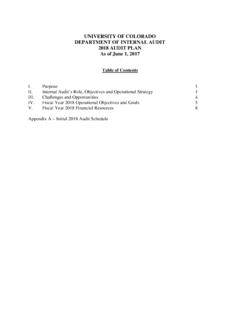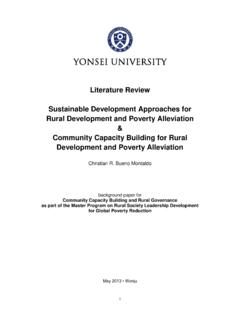Transcription of Five Approaches to Ethical Reasoning - University of Colorado
1 five Approaches toEthical ReasoningELP Program7 October 2016Dr. Nina PolokSources of Ethical Standards The Utilitarian Approach The Rights Approach The Justice and Fairness Approach The Common Good Approach The Virtue ApproachA Review of the five Approaches Review the criteria for each of the five Approaches As you read, note whether there is an approach you are attracted to and use most often Note whether there is one you use rarely or not at all Be prepared to discuss in your table groupThe Utilitarian Approach Utilitarianism holds that the morally right course of action in any situation is the one that produces the greatest balance of benefits over harms for everyone affected The focus is on the consequence of the action: the greatest good for the greatest number If the action produces the maximum benefits for everyone, it doesn t matter whether the benefits are produced by lies, manipulation or coercion Sometimes the end justifies the meansProblems with Utilitarianism How do we determine benefits and harms?
2 How do we assign value? the value of life, the value of money, the value of time, the value of human dignity? Can we ever calculate all the consequences of our actions? What of justice? What happens to minorities?The Rights Approach A long history: all endowed by their Creator with certain unalienable these are life, liberty, and the pursuit of happiness. A right is a justified claim on others A right to freedom means I have a claim to be left alone by others or, conversely, that others have a duty or responsibility to leave me aloneWhere Do Rights Come From? Many believe they are given by God: God-given right, endowed by their Creator Immanuel Kant believed they could be derived by the exercise of Reason The justification of a claim on others, a right, depends on some standard acknowledged and accepted by society, not simply the claim of an individual These may be codified in law, but they may also be moral standards that most people acknowledgeKant s Categorical Imperative For an action to be a moral must be amenable to being made consistently must respect rational beings as ends in themselves and not as means must stem from, and respect.
3 The autonomy of rational beings These three formulations are all aspects of the Categorical ImperativeNegative and Positive Rights Negative rights claim a zone of non-interference from others, right to freedom, right to privacy, right to bear arms Positive rights claim for each person the positive assistance of others in fulfilling basic elements of human well-being like heath and education Clearly, rights can be in conflict, and often areThe Justice and Fairness Approach Justice and Fairness means giving each person what he or she deserves Justice is more concerned with what is right generally, fairness is often about judgments specific to a particular case A long history: Plato s Republic to John Rawls A Theory of Justice How do we determine what people deserve?
4 Deciding What is Just and Fair Individuals should be treated the same, unless they differ in ways that are relevant to the situation in which they are involved Where might we see no relevant difference and thus treat people the same at work? Where might we see relevant difference and thus treat people differently at work?The Common Good An old notion: Plato, Aristotle, Cicero With a new twist from John Rawls: certain general conditions that equally to everyone s advantage. Having the social systems, institutions, and environments on which we all depend work in a manner that benefits all peopleThe Virtue Approach The previous Approaches focus on what people should do; the virtue approach focuses on what people should be Fundamental question: what kind of person should I be?
5 Virtues: attitudes, dispositions, character traits such as honesty, courage, compassion, generosity, fidelity, integrity, self-control, prudenceThe Virtue Approach Virtues are developed through learning and practice Character can be improved A virtuous person will be naturally disposed to act consistent with moral principles Virtues are developed within communitiesSources MarkkulaCenter for Applied Ethics, Santa Clara University Richard T. DeGeorge, Business Ethics, third edition, Macmillan, 1990














